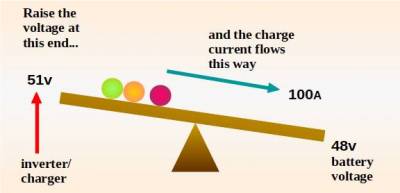Posted by: @murchison2003Can’t really fault the system but only drawback is that the batteries will only charge and discharge at around 3 kw
Really?! I swear I had read it was 5kW!! i just tried to find the info on the datasheet I have but can't see it! It's only got the charge/discharge figure as current. To be honest, I have no idea how to interpret current in realtion to charging/discharging! Why does does current and wattage appear to get used interchangably for this....??
The data sheet states max charge and max continous discharge as 100A, and peak discharge (3sec) as 350A. Is 100A the same as 3kW? Surely it's not as simple as that?!
I'm not an electrician and don't know anything about the bumf amps/kw but i remember the salesman telling me this when he sold them and that's what my inverter is showing 3-3.3 kw.
@transparent seems to be a wiz with this stuff, so hopefully they can provide some explanation! 😀
Posted by: @squeakysimPosted by: @murchison2003Can’t really fault the system but only drawback is that the batteries will only charge and discharge at around 3 kw
Really?! I swear I had read it was 5kW!! i just tried to find the info on the datasheet I have but can't see it! It's only got the charge/discharge figure as current. To be honest, I have no idea how to interpret current in realtion to charging/discharging! Why does does current and wattage appear to get used interchangably for this....??
The data sheet states max charge and max continous discharge as 100A, and peak discharge (3sec) as 350A. Is 100A the same as 3kW? Surely it's not as simple as that?!
The formula is quite simple, Watts = Volts x Amps.
In the case of batteries, the voltage is dependent upon how many are connected in series. A typical home battery system would be arranged to have a nominal voltage of 48 Volts, so if it was discharging at a rate of 100 Amps, then the power output in Watts would be:-
Watts = 48 x 100 = 4800 Watts, or 4.8kW.
If the inverter could handle 4.8kW of power, then the output on the AC side would be approximately 240 Volts x 20 Amps = 4.8kW. Because the inverter is not 100% efficient, then the actual power output would be slightly lower than this.
If your inverter is limited to a power output of 3kW, then the current on the AC side would be Amps = Watts / Volts, so Amps = 3000 / 240 = 12.5 Amps.
On the DC side the current flowing would be in the region of Amps = 3000 / 48 = 62.5 Amps.
@derek-m thanks for that.
So it's seems the inverter is restricting the battery capabilities in the case of @murchison2003 then...?
According to the datasheet the DC Purestorage 2 has charging capability of 5.7kW (100A x 57V) and discharge of 4.6kW (100A x 46V).
So if these were situated in series the capacity would be multiplied by the number of batteries installed, up to the limitation of the installed inverter, is that right?
Posted by: @squeakysim@derek-m thanks for that.
So it's seems the inverter is restricting the battery capabilities in the case of @murchison2003 then...?
According to the datasheet the DC Purestorage 2 has charging capability of 5.7kW (100A x 57V) and discharge of 4.6kW (100A x 46V).
So if these were situated in series the capacity would be multiplied by the number of batteries installed, up to the limitation of the installed inverter, is that right?
Transparent would be better able to answer your question, but the District Network Operator (DNO) normal limits the permitted export to the grid to 3.6kW, which may be the reason why a 3kW capacity inverter would be used.
If you look at some of Transparent's previous post, he explains this quite clearly.
Posted by: @squeakysimthe DC Purestorage 2 has charging capability of 5.7kW (100A x 57V) and discharge of 4.6kW (100A x 46V).
That information on the datasheet isn't helpful.
The point is that a PureStorage 2 battery can charge and discharge at 100A maximum. Converting it to kW (multiplying by the voltage) is confusing. That 57v is there because the internal LiFePO4 cells require it in order to allow 100A to flow.
Posted by: @squeakysimSo if these were situated in series the capacity would be multiplied by the number of batteries installed, up to the limitation of the installed inverter, is that right?
Erm... you wouldn't connect such batteries in series.
Check what @murchison2003 wrote:
I have 20 kw of Puredrive storage, 4 x 5kw DC batteries linked to my Solis Hybrid inverter
So that's four 5kW batteries in parallel, constrained by whatever charge/discharge currents are available from the single Solis inverter.
Thus, for example, if the inverter can charge at 100A, then the current will shared between the four batteries at 25A each.
In practice you don't achieve an even charge-rate because the battery with the shortest cables between it and the inverter will take proportionally more of the charge-current. Cable lengths matter, as do the number of connectors.
As @derek-m says, export to the Distribution Grid is limited to the level set by the Distribution Network Company which maintains that grid in your geographical region.
The default level is 16A per phase, which equates to 3.68kW. That's referred to as G98 approval.
There are some inverters which have an approved current sensing system that can discern the difference between the energy being exported to the grid and that being used within your own house.
It sounds like your Installer didn't fit such a unit for you, which is why you've ended up with a Solis inverter that has a fixed-current output - a 3.6kW unit.
I'll create and post a diagram showing these two options if you like. Please ask.
Save energy... recycle electrons!
@transparent most other batteries I've looked at give the charge/discharge rates in kWh, so I want to convert it so I can get a sound reference point as what load the battery can give the house before we'd need to draw from the grid.
Are you saying the calculations are incorrect or they just don't represent what I'm trying to determine? If so, how do I calculate the the discharge rate in kWh to understand the max amount of load the battery can take?
The reason I mentioned the batteries in series was because I was trying to make sense of their claim of maximum discharge rates. However, if I understand what you're saying correctly, then the inverter is the deciding factor on how much power the house can draw from the battery when the max discharge of the battery is in excess of the inverter rating?
Sorry, I don't even know if what I'm saying makes sense! I'm very much walking around with my L plates on here!!
@squeakysim you aren't the only one.
I've a 3.6kW solis inverter so this pretty much sets the limit on what the batteries can discharge. I say pretty much, as I have observed higher discharge rates and understand the system will tolerate them for short periods.
I did wonder initially why the installer would put the "bottleneck" of a 3.6kW inverter alongside batteries that are themselves capable of more. It's tied to the G98 approval I understand - you can seek a higher approval but I'm told it's a quite involved process. In practice though, I think this apparent restriction makes very little difference and it would only really be noticeable if you've a big household demand, say washing machine and cooker on, when you might need some grid import. Unless you're wanting a completely off-grid solution then this isn't a problem
There's so many variables in all this that it's very easy to over-analyse and disappear down a rabbit hole. A decent size battery will maximise your utilisation (and savings) from your PV and minimises grid imports, with further potential benefit through tariff management and playing tunes with your appliance on times. I'm not sure when I became 'Facilities Manager' for my property but it looks like it's happened......
2 x 12kW Samsung Gen6 ASHP, 5.6kW solar PV ground mounted c/w 10kWh Puredrive battery & Solis inverter.
I hear you @dunlorn!
I'm not sure, but I'm thinking that the higher charge/discharge capacity comes into play even moreso when there is TOU tariffs so you can really maximise those cheap rates and charge you battery more quickly. Which would have it's biggest benefit in the winter I'm sure!
@squeakysim I think you're right there. If you've only a brief window of cheap tariff, getting as much as you can into the battery will be the aim. Same thing if you've only a few hours sunshine on a cloudy day, capture as much as you can as soon as you can.
However, even at 3.6kW charge it won't need long to get close to capacity in a 10kWh battery (to use my example) and my impression, so far at least, is that going for a bigger inverter size would have marginal gain.
With hindsight, and if my budget was a load bigger, I'd have put more batteries in and (probably) a bigger inverter. That way I could've stored, at cheap rate, a significant chunk of what my ASHP is consuming at 34p/kWh. In this weather what I'm storing is tiny compared to consumption. The Puredrive batteries are modular though so, with the benefit of a bit more use and experience, it's something I might consider in future.
2 x 12kW Samsung Gen6 ASHP, 5.6kW solar PV ground mounted c/w 10kWh Puredrive battery & Solis inverter.
Posted by: @squeakysimmost other batteries I've looked at give the charge/discharge rates in kWh, so I want to convert it so I can get a sound reference point...
I think better in diagrams.
May I present this analogy as to how a battery is charged:
You set the charge current at 100A.
To achieve that, the inverter raises the voltage at its output until the 100A is detected.
So in the above diagram, the battery which is presently resting at 48v, gets presented with 51v.
You might suggest that the inverter is therefore rated at 51v x 100A which comes to 5100w, or 5.1kW
But a few hours later, the battery is reaching the end of its charge cycle. The battery voltage has risen to 57v (3.56v per cell):
Looking at the inverter end, it now records 59.3v x 100A, which is 5.9kW.
But that's crazy. Neither the inverter nor the battery has changed, so how can we describe the inverter unit as having increased its specified charge rate by 15% ? 😖
Converting the measurement to kW hasn't provided us with a 'sound reference point' at all.
It's just an illusion to portray one inverter/charger as being more powerful than another.
Chinese suppliers do this all the time! Grrr!
Given the fact that we are dealing with a battery whose voltage changes according to the State of Charge (SoC), there's little point in looking at the charging side of the electrics to appreciate how much power can be delivered to the house (discharge).
If I do want to look at the battery side of the inverter at any point in a discussion, I usually make the maths easy by assuming that it has a 'nominal 50v'.
That's good enough to help me calculate cable-sizes etc.
50v x 100A = 5000w
That gives me a rough figure of the inverter being a 5kW device.
So on the house-side of the argument, whilst the battery is discharging, it will provide
- 21.74A at 230v AC
- or 20.8A at 240v AC
Your actual grid/mains voltage differs according to local constraints and how the transformers are loaded.
In my area, I normally see around 246v, which means I can draw 20.3A.
But all of these figures on the mains side are still referring to the same 5kW unit.
Save energy... recycle electrons!
- 22 Forums
- 2,087 Topics
- 46 K Posts
- 45 Online
- 3,379 Members
Trusted Installers
Struggling to find a reliable heat pump installer? A poor installation can lead to inefficiencies and high running costs. We now connect homeowners with top-rated installers who deliver quality work and excellent service.
✅ Verified, trusted & experienced installers
✅ Nationwide coverage expanding
✅ Special offers available
Latest Posts
-

RE: Mitsubishi Ecodan Fails to Heat Water despite temperature drop
@m1kegibson Apologies if I'm teaching grandma to suck e...
By Gary , 33 minutes ago
-

RE: Air source heat pump roll call – what heat pump brand and model do you have?
@jamespa Hi, No major issues just learning to live...
By DowallyDrifter , 1 hour ago
-

RE: Solar to power Heat Pump for DHW
I was going to ask what model of Growatt inverter you h...
By Majordennisbloodnok , 2 hours ago
-

RE: Commencing on an ASHP Installation Process
Quick progress update. It looks like there are only 2 ...
By Sheriff Fatman , 5 hours ago
-

There are DHW tanks with a built in heat pump that take...
By JamesPa , 15 hours ago
-

RE: Vaillant AroTherm Plus 7kW
If the thermostat is connected to the call for heat ter...
By JamesPa , 23 hours ago
-

RE: Renewables & Heat Pumps in the News
Yes I realise I'm picking this up a week late...... but...
By Transparent , 2 days ago
-

@editor Mars if you have any recommendations for down s...
By abam48 , 3 days ago
-

RE: Surface mount or bury primaries for heat pump installation?
@tomasmcguinness HI, The rules is a best practise, the ...
By ASHP-BOBBA , 3 days ago
-

RE: Getting the best out of a heat pump - is Homely a possible answer?
@cathoderay how did you get a script to run for that- d...
By benson , 3 days ago
-

RE: Renewable Heating Hub Homeowners' Q&A Podcast
@ashp-bobba thank you, and equally so, thank you for ta...
By Mars , 4 days ago
-

@judith good to know… I’ll continue to feed Wattson, an...
By Mars , 5 days ago
-

RE: My misgivings about installing ASHP and solar panels via the ECO4 scheme...
@editor great article re accreditation. I note ISO/IEC ...
By Bart , 5 days ago
-

RE: Who's your electricity provider and what's your tariff?
I don't (yet), but my PW3 is due to be installed shortl...
By Old_Scientist , 6 days ago
-

RE: MCS and NAPIT complaints process
@chrislay, is your heat pump complaint still unresolved...
By Mars , 6 days ago
-

RE: ASHP Install from hell - help please
@saf1973 I’ve been going through old cases on the forum...
By Mars , 6 days ago
-

RE: RDSAP10 effect on existing heat pump EPC rating?
@aaron There's the rub, the database does not list my ...
By AF1 , 7 days ago






